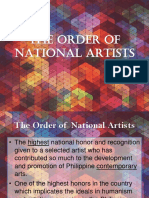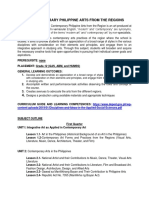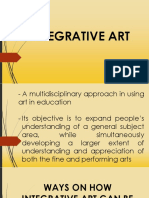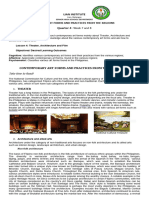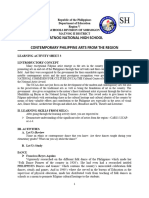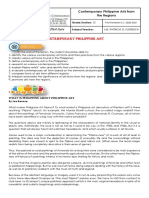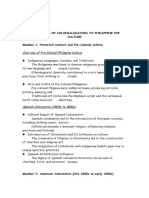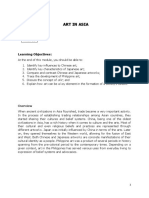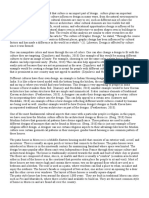Professional Documents
Culture Documents
Module 3 Contemporary Philippine Arts From The Regions
Module 3 Contemporary Philippine Arts From The Regions
Uploaded by
jessica navajaOriginal Description:
Original Title
Copyright
Available Formats
Share this document
Did you find this document useful?
Is this content inappropriate?
Report this DocumentCopyright:
Available Formats
Module 3 Contemporary Philippine Arts From The Regions
Module 3 Contemporary Philippine Arts From The Regions
Uploaded by
jessica navajaCopyright:
Available Formats
Teacher: JESSICA C.
NAVAJA FB Name: Jessica Navaja
CP #: 09552375954 Email Add: [email protected]
SIBUGAY TECHNICAL INSTITUTE
Lower Taway, Ipil, Zamboanga Sibugay
Tel-Fax #: (062) 333-2469
www.sibugaytech.com
Module 3 (Week 3): CONTEMPORARY ART FORMS AND PRACTICES FROM THE
REGIONS
Reference: Sandagan, Luviminda D.and Sayseng, Ayesha H., Contemporary Philippine Art from
the Regions, JFS Publishing Services,Manila., pp.2-6.
Mendez, Mario L. Jr.,Contemporary Philippine Art from the Regions, DIWA Learning
Systems Inc.,Philippines.,pp.2-6.
Module Overview
This lesson provides information about contemporary art forms mainly about Theater, Architecture and
Film. It aims to provide students’ knowledge about the various contemporary art forms and alo how to
conserved Filipino arts.
Lesson 3: Theater, Architecture and Film
Objectives/ Desired Learning Outcomes
Cognitive: Identifies various contemporary art forms and their practices from the various regions;
Affective: Appreciate contemporary art forms, found in the various regions;
Psychomotor: Classifies various art forms found in the Philippines.
CONTEMPORARY ART FORMS AND PRACTICES FROM THE REGIONS
Take time to Read!
The National Commission for Culture and the Arts, the official cultural agency of the government of the
Philippines, has categorized Filipino arts into traditional and non-traditional. Each category is split into
various arts, which in turn have sub-categories of their own.
1. THEATER
Theater has a long history in the Philippines. The basis of which is the folk performing arts under the
traditional arts. In the non-traditional category, theatrical direction, theatrical performance, theatrical
production design, theatrical light and sound design, and theatrical playwriting are the focal arts. Theater in
the Philippines is Malay in character, which is seen in rituals, mimetic dances, and mimetic customs of the
people. Plays with Spanish influences have affected Filipino theater and drama, notably the komedya, the
sinakulo, the playlets, the sarswela, and the Filipino drama. Puppetry, such as carrillo, is also a notable
theater art. In contrast, theater with Anglo-American influence has also mixed with various art forms such
as bodabil and the plays in English.
Tanghalang Pambansa Philam Life Theater National Cultural Treasure
Teacher: JESSICA C. NAVAJA FB Name: Jessica Navaja
CP #: 09552375954 Email Add: [email protected]
2. Architecture and allied arts
Architecture under the category of non-traditional arts focuses on non-folk architecture and its allied arts
such as interior design, landscape architecture, and urban design.
Non-folk architecture
The basis of Filipino non-folk architecture is the folk architecture of various ethnic groups within the
Philippines. The diversity in vernacular architecture range from the bahay kubo, bahay na
bato, torogan, idjang, payyo, and ethnic shrines and mosques. Upon the arrival of the Spanish in the 16th
century, various Western architectures were introduced such as Baroque, which was used to establish
the Manila Cathedral and Boljoon Church. However, due to the geologic nature of the islands, the Baroque
architecture was later turned into a unique style now known as Earthquake Baroque, which was used into the
building of Binondo Church, Daraga Church, and the world heritage sites of Paoay Church, Miagao
Church, San Agustin Church, and Santa Maria Church. Throughout the colonial eras, from Spanish to
American rule, various architecture styles were introduced. A notable Gothic Revival building is the San
Sebastian Church, the only all-steel church in Asia. Beaux-Arts became popular among the wealthy classes.
A notable example is the Lopez Heritage House. Art Deco continues to be a popular architecture in certain
Filipino communities, with the city of Sariaya considered as the country's Art Deco capital. Italian and
Italian-Spanish architecture can be seen on certain buildings such as Fort Santiago and The Ruins. Stick-
style is notable among some wood buildings such as the Silliman Hall. Neoclassical is perhaps the most
vividly depicted in the Philippines, as many government buildings follow the architecture. Examples include
the Baguio Cathedral, Manila Central Post Office, and the National Museum of Fine Arts. Even after
independence, architecture continued to evolve, with the usage of Brutalist architecture during the martial
law era. After the restoration of democracy, a revival of indigenous architecture into neo-vernacular
architecture occurred in the late 20th century and the 21st century. These buildings and structures have
become iconic bases for Filipino nationalism and ethnic representation. Modern-style architecture is
presently a popular style in the Philippines; with some examples include the Saint Andrew the Apostle
Church and the Manila Hotel. In the present era, demolitions of culturally important buildings and structures
have happened, despite the enactment of laws disallowing such acts. Many cultural workers and architects
have made advances to stop the demolitions of certain buildings and structures.
Zamboanga's Fort Pilar, a National Cultural Treasure Ipil Provincial Capitol (Zamboanga Sibugay)
Architecturally allied arts
The allied arts of architecture include interior design, landscape architecture, and urban design. Interior
design in the Philippines has been influenced by indigenous Filipino interiors and cultures, Hispanic styles,
American styles, Japanese styles, modern design, avant-garde, tropical design, neo-vernacular, international
style, and sustainable design. As interior spaces are expressions of culture, values, and aspirations, they have
been heavily researched on by Filipino scholars. Common interior design styles in the country for decades
have been Tropical, Filipino, Japanese, Mediterranean, Chinese, Moorish, Victorian, and Baroque, while
Avant Garde Industrial, Tech and Trendy, Metallic Glam, Rustic Luxe, Eclectic Elegance, Organic
Opulence, Design Deconstructed, and Funk Art have recently become popular. Landscape architecture in the
Philippines initially followed the client's opulence, however, in recent years; the emphasis has been on the
ecosystem and sustainability. Urban planning is a key economic and cultural issue in the Philippines, notably
Teacher: JESSICA C. NAVAJA FB Name: Jessica Navaja
CP #: 09552375954 Email Add: [email protected]
due to the high population of the country, marked with problems on infrastructures such as transportation.
Many urban planners have initiated proposals for the uplifting of urban areas, especially in congested and
flood-prone Metro Manila.
Dapitan Interior Church Obelisk rotunda of IPIL Wright Park in front of the Baguio Mansion
3. Film and broadcast arts
Film and broadcast arts focuses on the arts of direction, writing, production design, cinematography, editing,
animation, performance, and new media.
The origin of the cinematic arts in the Philippines officially began in 1897, upon the introduction of moving
pictures into Manila. Filipinos aided foreign filmmakers in the Philippines for a time, until in 1919, when filmmaker José
Nepomuceno made the first ever Filipino film, Dalagang Bukid (Country Maiden). By the 1930s, the formative years of
Filipino cinema began as interest in film genre as art began among the common folk. Theatre became an important
influence to the boom of cinema in the Philippines. The 1940s created films that would point towards the reality of the
people, due to the occupation years during World War II. More artistic and mature films sprang a decade later under the
banner of quality films, as perceived at the time. The 1960s showed an era of commercialism, fan movies, soft
porn films, action flicks, and western spin-offs, until the golden age of cinema met the turbulent years from the 1970s to
1980's due to the dictatorship. The films under the period were overseen by the government, with various filmmakers being
arrested. A notable film made during the period is Himala, which tackles the concept of religious fanaticism. The period
after martial rule dealt with more serious topics, with independent films being made by many filmmakers. The 1990s saw
the emergence of films related to Western films, along with the continued popularity of films focusing on the realities of
poverty. Among the direst films at the time include Manila in the Claws of Light, The Flor Contemplacion Story, Oro,
Plata, Mata, and Sa Pusod ng Dagat. Cinema in 21st century Philippines has met a revival of popular watchings, with films
being produced by various fronts. Films regarding human equality, concepts of poverty, self-love, and historical narratives
have met popular success. Key films during the era include The Blossoming of Maximo Oliveros, Caregiver, Kinatay, Thy
Womb, That Thing Called Tadhana, The Woman Who Left, and the film version of the book Smaller and Smaller Circles.
A postcard for the film, Zamboanga
A cinema inside a Filipino mall Manila Film Center
Teacher: JESSICA C. NAVAJA FB Name: Jessica Navaja
CP #: 09552375954 Email Add: [email protected]
CONTEMPORARY FASHION DESIGN
Conservation of the Filipino arts
Museums are important vessels for the protection and conservation of Philippine arts. A number of
museums in the Philippines possess works of art that have been declared as National Treasures, notably
the National Museum of the Philippines in Manila. Other notable museums include Ayala Museum, Negros
Museum, Museo Sugbo, Lopez Museum, and Metropolitan Museum of Manila. University museums also
hold a vast array of art. Libraries and archives are also important, among the most known are the National
Library of the Philippines and the National Archives of the Philippines. Various organizations, groups, and
universities have also conserved the arts, especially the performing and craft arts.
Many conservation measures have been undertaken by both private and public institutions and
organizations in the country, in addressing the heritage management in the Philippines. The enactment of
laws such as the National Cultural Heritage Act have aided in Filipino art conservation. The act also
established the country's repository of all culturally-related heritages, the Philippine Registry of Cultural
Property. The National Commission for Culture and the Arts is currently the official cultural arm of the
Philippine government. There have been proposals to establish a Philippine Department of Culture.
ACTIVITY 1
Direction: Write the correct answer.
__________1. He is the one who introduced modern visual art in the country through his exhibition.
__________2. It is the kind of art which depicts the life after the war, and economic problems.
__________3. Another term for Filipino Pop Music.
__________4. It is a kind of poetry which uses colloquial language and built on concrete images which
tend to describe experiences.
__________5. It refers to the style in a painting showing minute details of subjects highlighting their
texture and color.
SELF- CHECK
Direction: Identify what kind of art forms are the following:
1. Dalagang Bukid __________ 6. Bodabil __________
2. Manila Cathedral __________ 7. Zarzuela __________
3. T’nalak Weaving __________ 8. Planting Rice __________
4. That Thing Called Tadhana __________ 9. The Meztiza __________
5. Puppetry __________ 10. Flor Contemplacion Story__________
Teacher: JESSICA C. NAVAJA FB Name: Jessica Navaja
CP #: 09552375954 Email Add: [email protected]
SELF- REFLECT
1. How can you describe the characteristics of different contemporary art forms which are Theater,
Architecture and Film?
_________________________________________________________________________________
_________________________________________________________________________________
_________________________________________________________________________________
_________________________________________________________________________________
_________________________________________________________________________________
2. What are the regional initiatives in preserving and promoting contemporary arts like Theater, Dance,
Architecture and Film?
_________________________________________________________________________________
_________________________________________________________________________________
_________________________________________________________________________________
_________________________________________________________________________________
_________________________________________________________________________________
3. Define contemporary arts in the Philippines.
_________________________________________________________________________________
_________________________________________________________________________________
_________________________________________________________________________________
_________________________________________________________________________________
_________________________________________________________________________________
You might also like
- Pricelist Citi HardwareDocument11 pagesPricelist Citi HardwareAlvarez Gayle60% (5)
- Ajay Patel House Indian Architecture Group Contemporary Houses Vol 2Document16 pagesAjay Patel House Indian Architecture Group Contemporary Houses Vol 2Nikhil RanaNoch keine Bewertungen
- Contemporary Philippine Arts From The RegionsDocument1 pageContemporary Philippine Arts From The RegionsMhyra Aquino63% (8)
- Boq - Fencing EstimateDocument2 pagesBoq - Fencing EstimateAugustine Believe100% (4)
- CPAR11 Q1 Mod2 Contemporary-Arts-in-the-Philippines v3Document50 pagesCPAR11 Q1 Mod2 Contemporary-Arts-in-the-Philippines v3Em Gongora Jr.67% (3)
- ContextDocument30 pagesContextErwil AgbonNoch keine Bewertungen
- Contemporary ArtsDocument50 pagesContemporary ArtsWendell Eleguen67% (3)
- The Order of National ArtistsDocument25 pagesThe Order of National ArtistsAllysa LacorteNoch keine Bewertungen
- Big BenDocument3 pagesBig Benameliarizka880% (1)
- Contemporary Philippine Arts From The RegionsDocument10 pagesContemporary Philippine Arts From The RegionsOdessa L. Urgel100% (1)
- Module 2 Contemporary Philippine Arts From The RegionsDocument7 pagesModule 2 Contemporary Philippine Arts From The Regionsjessica navaja75% (4)
- M1 IntroductionDocument12 pagesM1 IntroductionHa HatdogNoch keine Bewertungen
- Module 1 Contemporary Philippine Arts From The RegionsDocument9 pagesModule 1 Contemporary Philippine Arts From The Regionsjessica navaja100% (1)
- Contemporary Arts in The Philippines Chapter 2 Lesson 2Document23 pagesContemporary Arts in The Philippines Chapter 2 Lesson 2Jomarie Sahhara Grande Turtoga50% (4)
- Contemporary Philippine Arts From The Regions Week 1Document9 pagesContemporary Philippine Arts From The Regions Week 1Jean Harriet obreroNoch keine Bewertungen
- Module 2 - Lesson 6 - Contemporary ArtsDocument9 pagesModule 2 - Lesson 6 - Contemporary ArtsCressia Mhay BaroteaNoch keine Bewertungen
- Contemporary Philippine Arts From The Regions MODULE 3Document4 pagesContemporary Philippine Arts From The Regions MODULE 3JOHN RULF OMAYAN0% (1)
- Module in Contemporary Philippine Arts From The Regions 1 Quarter, Week 1Document10 pagesModule in Contemporary Philippine Arts From The Regions 1 Quarter, Week 1Agnes Ramo78% (9)
- Contemporary Philippine Arts From The Region: Try It Out!Document7 pagesContemporary Philippine Arts From The Region: Try It Out!Master NistroNoch keine Bewertungen
- Cpar-Q4-Week-5-6-Shiela May RamirezDocument4 pagesCpar-Q4-Week-5-6-Shiela May Ramirezshiela verzosaNoch keine Bewertungen
- History of Philippine ArtsDocument24 pagesHistory of Philippine ArtsAlexander V. GarciaNoch keine Bewertungen
- Activity 4: Contemporary Philippine Arts From The RegionsDocument2 pagesActivity 4: Contemporary Philippine Arts From The RegionsRachelle OlañoNoch keine Bewertungen
- Title: Contemporary Philippine Arts From The RegionsDocument79 pagesTitle: Contemporary Philippine Arts From The Regionsallysa canale100% (1)
- Mini Lecture and Activity Sheets in Contemporary Philippine Arts From The Regions Quarter 4, Week 4Document5 pagesMini Lecture and Activity Sheets in Contemporary Philippine Arts From The Regions Quarter 4, Week 4Darlene Dacanay DavidNoch keine Bewertungen
- Different Contemporary Art Techniques and PerformanceDocument34 pagesDifferent Contemporary Art Techniques and PerformanceCrystal Renz M TibayanNoch keine Bewertungen
- Cpar Integrative ArtDocument13 pagesCpar Integrative ArtDonna Mae Icabandi Teñoso50% (2)
- Art Promotion and PreservationDocument25 pagesArt Promotion and PreservationAngielyn Lucasan100% (1)
- Historical Background of Philippine Contemporary ArtsDocument28 pagesHistorical Background of Philippine Contemporary Artsehlie canlas33% (3)
- CAR National Artists in The Philippines July 29-August 2, 2019Document34 pagesCAR National Artists in The Philippines July 29-August 2, 2019johrevzNoch keine Bewertungen
- GAMABADocument28 pagesGAMABANadia Wan100% (1)
- Contemporary Philippine Arts From The Region Is Your Stepping Stone To Understanding TheDocument9 pagesContemporary Philippine Arts From The Region Is Your Stepping Stone To Understanding TheDondee Palma75% (4)
- Contemporary Art Techniques and Performance PracticesDocument37 pagesContemporary Art Techniques and Performance PracticesCiryll IbitaNoch keine Bewertungen
- MODULE CPAR Whole 1st QuarterDocument106 pagesMODULE CPAR Whole 1st QuarterJeffrey De Belen100% (5)
- Contemporary Philippine Art From The RegionDocument89 pagesContemporary Philippine Art From The RegionVince Aguirre60% (10)
- Contemporary Philippine Arts From The Regions: Kto12 CurriculumDocument18 pagesContemporary Philippine Arts From The Regions: Kto12 CurriculumKathleen Joy Permangil100% (4)
- Contemporary Philippine Arts From The Regions Module 3 Q1Document29 pagesContemporary Philippine Arts From The Regions Module 3 Q1Jhoy Llandelar50% (2)
- LAS Contemporary-Arts Grade-12 Week-2Document7 pagesLAS Contemporary-Arts Grade-12 Week-2esterlitaNoch keine Bewertungen
- Contemporary Arts Q2 M2Document3 pagesContemporary Arts Q2 M2Cloue Faye I. Basallo90% (10)
- Activity Sheets in Contemporary Philippine Arts From The Regions Quarter 4, Week 5-6Document2 pagesActivity Sheets in Contemporary Philippine Arts From The Regions Quarter 4, Week 5-6Bea Chan100% (1)
- 4.1 Introduction To Philippine Artists and Their Contributions To Contemporary ArtsDocument79 pages4.1 Introduction To Philippine Artists and Their Contributions To Contemporary ArtsHans Sicangco78% (18)
- CPAR Quarter 1 Module 3Document2 pagesCPAR Quarter 1 Module 3WayneNoch keine Bewertungen
- Contemporary Phil Arts From The RegionsDocument25 pagesContemporary Phil Arts From The Regionsjohn mark moralesNoch keine Bewertungen
- Contemporary Arts in The PlhilippinesDocument3 pagesContemporary Arts in The PlhilippinesWenzel Kenn SanchezNoch keine Bewertungen
- Contemporary Philippine Arts From The RegionsDocument30 pagesContemporary Philippine Arts From The RegionsG'day MateNoch keine Bewertungen
- Contemporary Arts Philippine Arts From The RegionDocument29 pagesContemporary Arts Philippine Arts From The RegionNilo Bri100% (1)
- Q1. W1. Introduction To Philippine Contemporary Arts From The Regions and Its Various Forms and PracticesDocument6 pagesQ1. W1. Introduction To Philippine Contemporary Arts From The Regions and Its Various Forms and PracticesDazzle MuliNoch keine Bewertungen
- Contemporary Philippine Arts From The Region - Grade12-Quarter-2-Week5Document7 pagesContemporary Philippine Arts From The Region - Grade12-Quarter-2-Week5Rutchel100% (1)
- ContemporaryArts12 Q1 Mod3 Contemporary Arts Forms Ver3Document27 pagesContemporaryArts12 Q1 Mod3 Contemporary Arts Forms Ver3Bernadette Reyes100% (2)
- Lesson 6: Traditional Techniques To Contemporary Art Creations Lesson 6: Traditional Techniques To Contemporary Art CreationsDocument59 pagesLesson 6: Traditional Techniques To Contemporary Art Creations Lesson 6: Traditional Techniques To Contemporary Art CreationsZhedriex EspirituNoch keine Bewertungen
- Introduction To Contemporary Arts in The PhilippinesDocument25 pagesIntroduction To Contemporary Arts in The PhilippinesChristine Allen AcuñaNoch keine Bewertungen
- CPAR Quarter 1 Module 6Document3 pagesCPAR Quarter 1 Module 6WayneNoch keine Bewertungen
- National Living Treasures - GAMABADocument4 pagesNational Living Treasures - GAMABAMaria Samantha FloresNoch keine Bewertungen
- EDITED Corrected-Module - CPAR - Module1 - AmboyDocument24 pagesEDITED Corrected-Module - CPAR - Module1 - AmboyGabriel Cabansag0% (2)
- LESSON 4 - Contemporary Philippine Arts From The RegionDocument12 pagesLESSON 4 - Contemporary Philippine Arts From The RegionAlex Abonales Dumandan100% (12)
- Contempo ArtsDocument12 pagesContempo ArtsJM Heramiz60% (5)
- Luzonian Center of Excellence For Science and Technology (LCEST) IncDocument5 pagesLuzonian Center of Excellence For Science and Technology (LCEST) IncArnel Sumagaysay Gallo100% (2)
- Contemp Week 7 and 8Document12 pagesContemp Week 7 and 8Rollie Boy EsguerraNoch keine Bewertungen
- LAS 3 ContemporaryDocument5 pagesLAS 3 ContemporaryKevin Viernes GaraisNoch keine Bewertungen
- Some Notable Filipino Artists (PARADO)Document4 pagesSome Notable Filipino Artists (PARADO)Juzz Casiano ParadoNoch keine Bewertungen
- Filipino Artist and Their Contributions Quarter 1, Module 3: Contemporary Philippine Arts From The RegionDocument51 pagesFilipino Artist and Their Contributions Quarter 1, Module 3: Contemporary Philippine Arts From The RegionMhay Anne PerezNoch keine Bewertungen
- Contemporary Philippine Arts From The RegionsDocument12 pagesContemporary Philippine Arts From The RegionsKarla Joy Corpuz Marciano100% (1)
- Contemporary Philippine Art: Module 2 - Phil ArtsDocument9 pagesContemporary Philippine Art: Module 2 - Phil ArtsPatricia Diego Floresca100% (1)
- The Effects of Colonialization To Philippine Pop CDocument9 pagesThe Effects of Colonialization To Philippine Pop CPangan, Poala Ruth Ashley C.Noch keine Bewertungen
- Department of Education: Philippine Contemporary Arts in The Region Quarter3-Week3-4Document6 pagesDepartment of Education: Philippine Contemporary Arts in The Region Quarter3-Week3-4Dionel T. Galagar LptNoch keine Bewertungen
- Stii LP Sentence ConstructionDocument7 pagesStii LP Sentence Constructionjessica navajaNoch keine Bewertungen
- Course Code: Course Name: Course Credits: Contact Hours: Pre-Requisite: None Type of Course: Pre-Requisite Course TODocument22 pagesCourse Code: Course Name: Course Credits: Contact Hours: Pre-Requisite: None Type of Course: Pre-Requisite Course TOjessica navajaNoch keine Bewertungen
- Lower Taway, Ipil, Zamboanga Sibugay WWW - Sibugaytech.edu - PH: Sibugay Technical Institute IncDocument2 pagesLower Taway, Ipil, Zamboanga Sibugay WWW - Sibugaytech.edu - PH: Sibugay Technical Institute Incjessica navajaNoch keine Bewertungen
- Amor PropioDocument13 pagesAmor Propiojessica navajaNoch keine Bewertungen
- ABELLANOSADocument3 pagesABELLANOSAjessica navajaNoch keine Bewertungen
- English Unit Test (JHS) Name: - Grade&Sec: - Date: - ScoreDocument3 pagesEnglish Unit Test (JHS) Name: - Grade&Sec: - Date: - Scorejessica navajaNoch keine Bewertungen
- Purposive CommunicationDocument36 pagesPurposive Communicationjessica navajaNoch keine Bewertungen
- Institutional Assessment AnswerDocument5 pagesInstitutional Assessment Answerjessica navajaNoch keine Bewertungen
- Training Session Evaluation FormDocument6 pagesTraining Session Evaluation Formjessica navajaNoch keine Bewertungen
- Lesson: Art of Emerging EuropeDocument15 pagesLesson: Art of Emerging Europejessica navaja100% (2)
- Lesson: Soulmaking, Appropriation and ImprovisationDocument11 pagesLesson: Soulmaking, Appropriation and Improvisationjessica navajaNoch keine Bewertungen
- Lesson: Caught in Between: Modern and Contemporary ArtDocument14 pagesLesson: Caught in Between: Modern and Contemporary Artjessica navajaNoch keine Bewertungen
- Is An Ideology Based On The Belief That People, Goods and Information Ought To Be Able To Cross National Borders UnfetteredDocument3 pagesIs An Ideology Based On The Belief That People, Goods and Information Ought To Be Able To Cross National Borders Unfetteredjessica navajaNoch keine Bewertungen
- Lesson: Artists and ArtisansDocument15 pagesLesson: Artists and Artisansjessica navajaNoch keine Bewertungen
- Module 11Document14 pagesModule 11jessica navajaNoch keine Bewertungen
- PRE ASSESSMENT and DATA GATHERINGDocument5 pagesPRE ASSESSMENT and DATA GATHERINGjessica navajaNoch keine Bewertungen
- Trainee'S Record Book: Sibugay Technical Institute Incorporated Lower Taway, Ipil, Zamboanga SibugayDocument15 pagesTrainee'S Record Book: Sibugay Technical Institute Incorporated Lower Taway, Ipil, Zamboanga Sibugayjessica navajaNoch keine Bewertungen
- Learning Plan: Grade 10 Unit TopicDocument3 pagesLearning Plan: Grade 10 Unit Topicjessica navajaNoch keine Bewertungen
- National Artist of The PhilippinesDocument8 pagesNational Artist of The Philippinesjessica navajaNoch keine Bewertungen
- Pre-Testpost-Test: T-Test: Paired Two Sample For MeansDocument3 pagesPre-Testpost-Test: T-Test: Paired Two Sample For Meansjessica navajaNoch keine Bewertungen
- Various Contemporary Art FormsDocument6 pagesVarious Contemporary Art Formsjessica navajaNoch keine Bewertungen
- Lesson 4: The Contemporary in Traditional Art: Gawad Sa Manlilikha NG Bayan (Gamaba)Document11 pagesLesson 4: The Contemporary in Traditional Art: Gawad Sa Manlilikha NG Bayan (Gamaba)jessica navaja100% (1)
- 9 AreasDocument1 page9 Areasjessica navajaNoch keine Bewertungen
- E-Book On Buddhist ArchitectureDocument28 pagesE-Book On Buddhist ArchitectureChaarvee BevaraNoch keine Bewertungen
- Deccan Architecture-Gulburga & BidarDocument23 pagesDeccan Architecture-Gulburga & BidarSuhas KsNoch keine Bewertungen
- Advance Construction and MaterialsDocument23 pagesAdvance Construction and MaterialsSaki Saki SakiNoch keine Bewertungen
- Types of Ties Used in Building Construction, Their Design and Uses PDFDocument6 pagesTypes of Ties Used in Building Construction, Their Design and Uses PDFnasirjamal33Noch keine Bewertungen
- Akanksha T BeamDocument15 pagesAkanksha T Beammonika chauhanNoch keine Bewertungen
- Architectural Education in The Digital Agecomputer Applications: Between Academia and PracticeDocument10 pagesArchitectural Education in The Digital Agecomputer Applications: Between Academia and PracticedennisNoch keine Bewertungen
- Restaurant ResearchDocument8 pagesRestaurant ResearchRay MatthewNoch keine Bewertungen
- Compilation Requirements IN Architectural Design - 8 (Finals)Document5 pagesCompilation Requirements IN Architectural Design - 8 (Finals)Danica Mae AmicayNoch keine Bewertungen
- Briefing Schematic MasterplanDocument3 pagesBriefing Schematic MasterplanDandi MuhammadNoch keine Bewertungen
- Morocco 8Document2 pagesMorocco 8densamm60Noch keine Bewertungen
- Design Loads For ManholesDocument1 pageDesign Loads For ManholesDonald HamiltonNoch keine Bewertungen
- Characteristics of Contemporary ArtsDocument10 pagesCharacteristics of Contemporary ArtsAdrianeEsteban100% (1)
- Products: Ventilation Air Conditioning Refrigeration HeatingDocument16 pagesProducts: Ventilation Air Conditioning Refrigeration HeatingzainulmarengNoch keine Bewertungen
- Masonry Performance GuideDocument5 pagesMasonry Performance GuideShivanan SinghNoch keine Bewertungen
- 6 Cooling Load Rules of ThumbDocument10 pages6 Cooling Load Rules of ThumbRyanAdam100% (2)
- Metal Deck and Cast in ChannelsDocument8 pagesMetal Deck and Cast in ChannelsrealdarossNoch keine Bewertungen
- Ground Floor 40X80 Option-1Document1 pageGround Floor 40X80 Option-1Ashish SrivastavaNoch keine Bewertungen
- Professional Conduct, Scale of ChargesDocument28 pagesProfessional Conduct, Scale of ChargesDevNoch keine Bewertungen
- La Sainte ChapeleDocument3 pagesLa Sainte ChapeleLidia ZestreaNoch keine Bewertungen
- The Forbidden City: A Fortress of Palaces and Gardens, 1407-20Document1 pageThe Forbidden City: A Fortress of Palaces and Gardens, 1407-20Manoel GalvãoNoch keine Bewertungen
- Prefabricated StrucuresDocument36 pagesPrefabricated StrucuresMamthasenaNoch keine Bewertungen
- Double Layer Reinforcing Layout: 0 In. (Typ.)Document1 pageDouble Layer Reinforcing Layout: 0 In. (Typ.)mrmerajNoch keine Bewertungen
- Vintage Style Bathroom VanityDocument11 pagesVintage Style Bathroom VanityRonielle MercadoNoch keine Bewertungen
- Reinforced Concrete Design II - ACI 318: Design of Hollow Block and Ribbed SlabsDocument37 pagesReinforced Concrete Design II - ACI 318: Design of Hollow Block and Ribbed Slabsmedo eidNoch keine Bewertungen
- HPC Estimate & BOQDocument18 pagesHPC Estimate & BOQsujeetNoch keine Bewertungen
- CN7001-Advanced Concrete Technology QB PDFDocument6 pagesCN7001-Advanced Concrete Technology QB PDFlavanyaNoch keine Bewertungen







